-
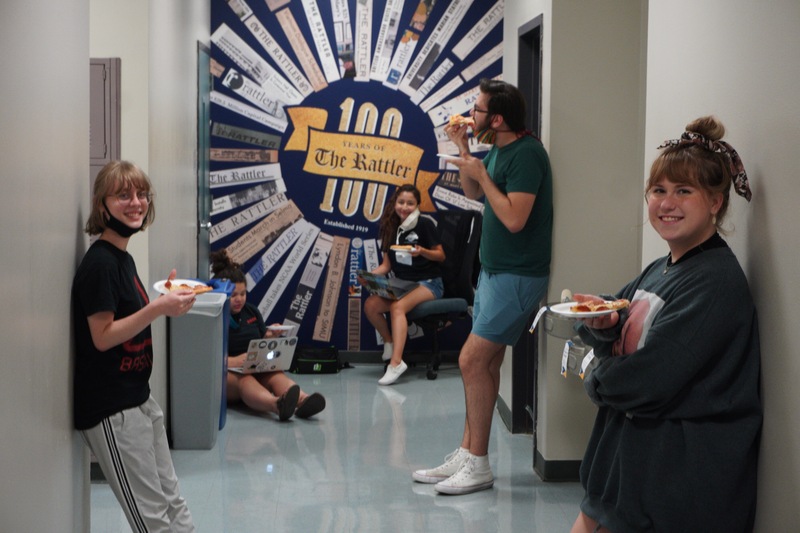
2020-08-29
This image was taken during The Rattler's first press weekend. Due to COVID-19 restrictions there is a no eating in the newsroom policy, and so staff now must eat outside in the hallway and maintain social distancing. This scene is typical of a late Saturday night (closer to midnight) as the staff is working to finish the upcoming paper, although now this gathering must take place in the hallway. The staff stays 6 feet apart to eat and due to only a set number of people being allowed in the newsroom at any given time some have taken camp out in the hallway to work "remotely" but still able to communicate quickly with the rest of the staff.
-
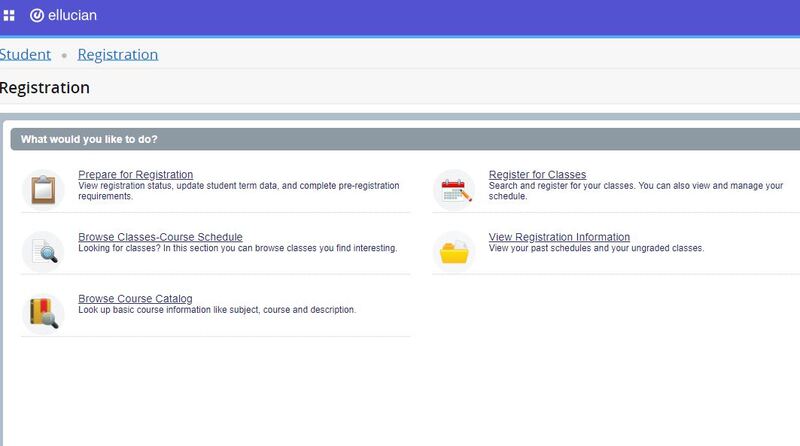
02/01/2020
Registering for my Masters program”2020” was a bit more difficult and time consuming than usual. During Covid-19 “Lock-Down” I could not walk into offices to take care of business like I normally do. Communication was directed through E-Mail, and video calls. First of all, I am not a big fan on emails. I have never considered it an official form of communication. I myself being in the military, and traveling the majority of the year, was subject to scrutiny about not responding to emails when I was traveling around the world. At the time, many places in the world did not have WIFI, and by the time I had arrived from my trips, deadlines had passed; not like I was going to make any kind of meeting while I was on the road anyway. The digital highway is not convenient for me for many forms of communication. Applying for Federal Aid was normal, that has been an online process sense the beginning of my college career but addressing my VA school benefits was another story. Contacting VA coordinators and councilors meant that communication drastically slowed down. During Covid-19, offices were closed, office workers were moving their offices home, and the VA was rapidly changing the process of doing business with its members. This meant that I could not meet with a benefits counselor in my hometown but get a response e-mail from them that would lead me to a national pool of counselors. Applying for school benefits and having the process approved took approximately 5 – 6 months, 4 maybe 5 months too long. I can only guess that the entire system has been compromised because of the Covid pandemic, and the slow to respond, “email effect.”
-
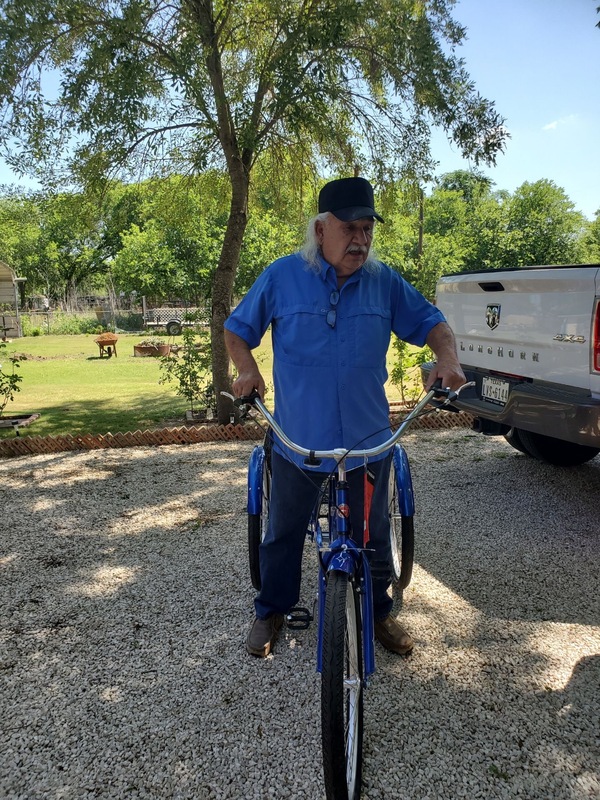
06/01/2020
February 2020, Covid-19 was a drop in the bucket, it’s coming to the U.S. from China. What is it? Where did it come from? How will it reach us? Do we close our boarders? Stop international travel? Who is to blame? The first of the infected to arrive, from China, landed at Kelly Field San Antonio TX, and were set into quarantine.
Fast forward about a month (end of March), and I am picking my dad up from BAMC (Brook Army Medical Center), he had been dropped off by his wife, and she was not allowed to stay at the hospital. He was seen at the ER because of stomach pain and continuous vomiting. What was different and a little strange to me was the fact that the hospital would not allow his wife to enter the building, even if she was the only means of his being. Because of strict city, state, and national orders to covid-19, no one other that the patient was allowed to enter the hospital.
After two months of going in and out of the hospital, military doctors had discovered a cancerous tumor growing in his liver, it was putting pressure against his bile duct not allowing his liver to function properly. An emergency procedure was scheduled, but without notice, it was cancelled before he was operated on. A second procedure (Y90) was scheduled, but part 1 of a two-part procedure failed and three days later we said goodbye to Art Reyes Sr.
Planning for his services were difficult. We could only invite 10 people to the church and 20 people to the funeral home, but after gathering information about my dad’s services, my heart went out to those that had lost family and friends due to the Covid virus. Their services were completely canceled. If a person had died in a hospital of Covid-19, they were to be transported from the hospital, cremated, and buried without any type of service
Had it not been for Covid-19, I think that Art Reyes would have had the rapid medical attention that he deserved. Doctors would have been “on the spot” in treating him for his condition, and not meeting just once a month to discuss someone’s condition with cancer. Many times, I felt that he was dismissed because of the covid-rules in place, but there also did not have to be poor/no communication between family and doctors. Funeral services would have been normal for more than 20 people to celebrate his death, and many family members that could not travel from out of town, could have celebrates with us also. The bottom line was his cancer inevitably was the cause for his death, but it wasn’t immediate. His death was due to his failing organs that were secondary to the tumor growth, and medical doctors on a “Corona19 Vacation.”
-
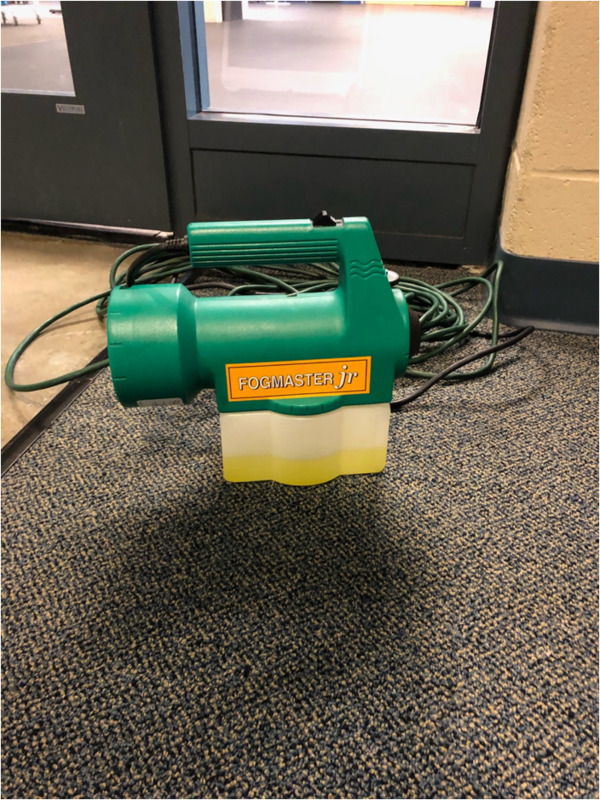
10/01/2020
This fogger is a new sanitization device introduced to our daily cleaning regime at the Athletic Center. It plays an integral part in ensuring that the recreation spaces are sanitized for patrons and for athletes to use the spaces. The fogger is used by custodial staff at 10:00 am and 2:00 pm and the facilities must be closed for an hour each time. The fogger is also used at a closing time ensuring that the facility is sanitized for incoming athletes for their 6:00 am sessions.
-
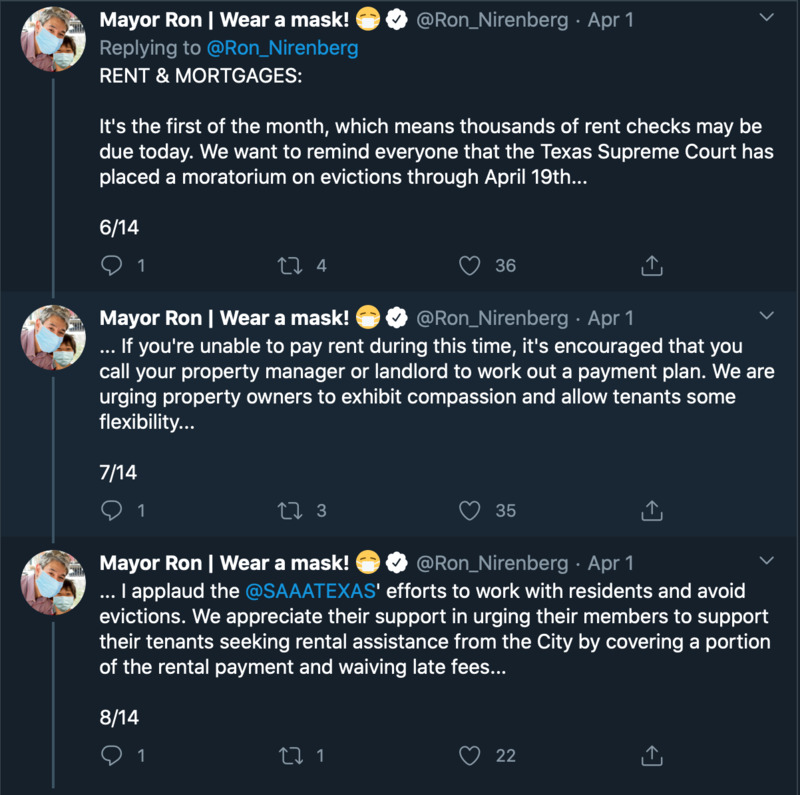
2020-04-01
These series of images are tweets from or about San Antonio mayor Ron Nirenberg and his administration's response throughout April 2020. These images illustrate the way local government mobilized to disperse political, economic, and medical information through social media. Information includes emergency orders, public and private assistance programs, case & hospital statistics, and where to get tested for COVID.
-
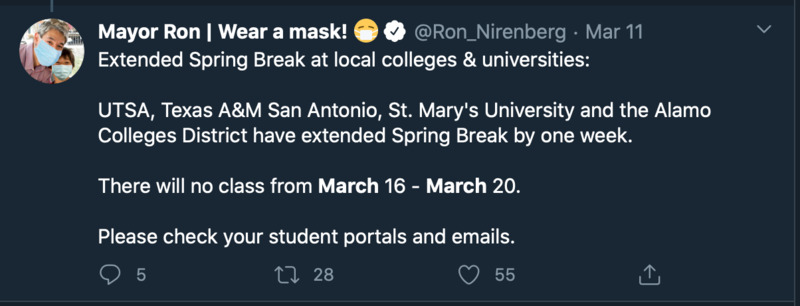
2020-03-11
These series of images are tweets from or about San Antonio mayor Ron Nirenberg and his administration's response throughout initial weeks of the COVID-19 outbreak & shutdown of San Antonio. These images illustrate the way local government mobilized to disperse political, economic, and medical information through social media.
Information such as executive orders, public and private programs, case statistics during the first weeks of the COVD crisis, city closures, how to stay safe, and where to get tested for COVID.
-

2020-04-29
This photograph is taken in Houston, TX as part of a news conference with Rep. Al Green and Houston Mayor Sylvester Turner. On 29 April 2020, the city of Houston staged a news conference at a COVID-19 testing site run by the National Guard in Houston, TX. At the end of the conference, LTC English (who is a Nurse Practitioner and Texas Army National Guard Senior Medical Advisor) was interviewed for his opinion on public health and safety during the pandemic.
-
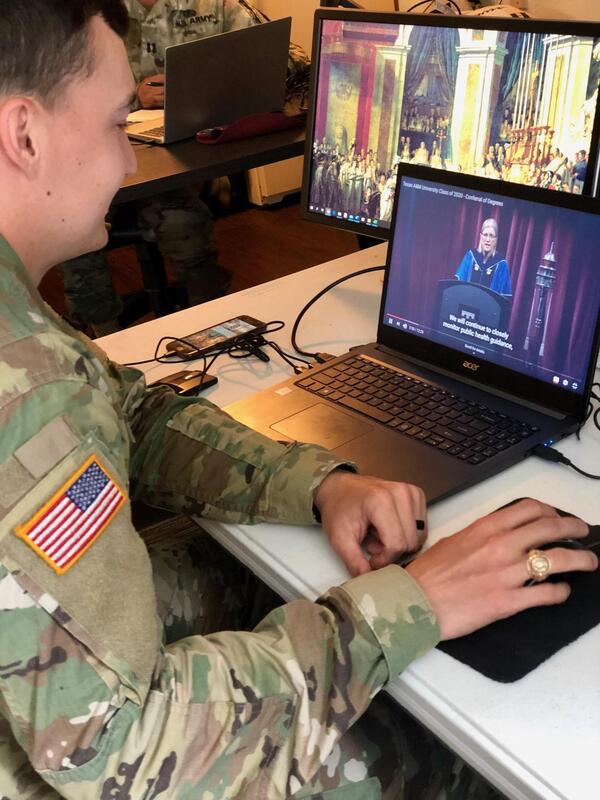
2020-05-09
I graduated from Texas A&M with my PhD in Anthropology in May 2020. The graduation was in early May. I had defended my dissertation in late January and was working as a graduate assistant at Texas A&M and as an instructor at Blinn College when the COVID-19 came to Texas in March 2020. My jobs went online for a month, then I was activated with the National Guard on 18April2020. In this photograph from early May, I am attending my remote graduation ceremony from my workspace at the Region 6 COIVD-19 Response headquarters in Houston, TX.
-
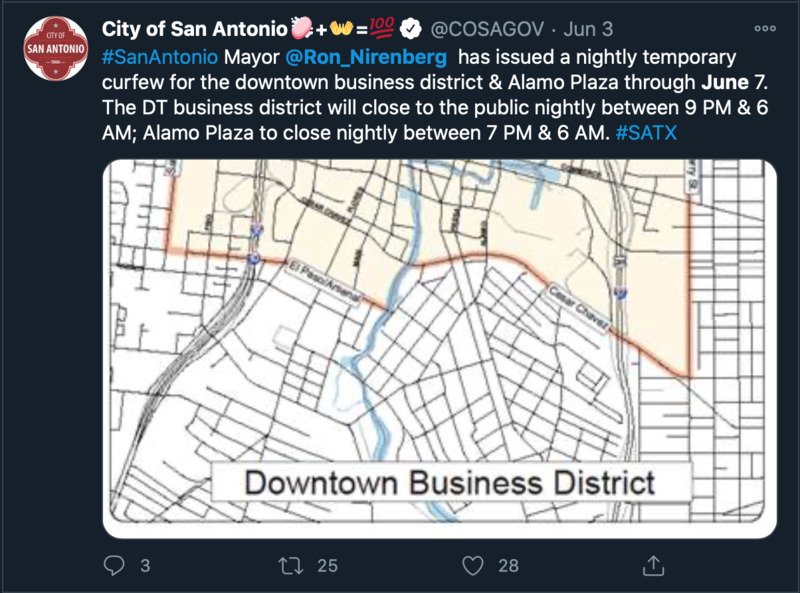
May 5, 2020 - August 31, 2020
This entry is the second part to capturing what the first six months of my graduate school experience was like. I’m a graduate student in the public history program at St. Mary’s University in San Antonio, Texas. I, like many students throughout all levels of education, felt a dramatic shift during or following spring break 2020. As the world began to catch on fire, I was just starting to piece together my final project which would enable me to graduate with my M.A. degree. Despite the chaos, I managed to survive the rest of the semester, and actually get a good head start on my project. I achieved two new job opportunities and reunited with my boyfriend after going two months without seeing each other. Things were going really well for me and I found a sense of confidence I hadn’t felt in three months. A confidence that might’ve crossed the line into arrogance.
This is when I actually got serious about the pandemic. I chose to forget that just because things were going well in my world, didn’t mean things were going well in the real world.
I, along with many of my fellow citizens, gave in to the idea that the south Texas heat would significantly curb the spread of the virus. As Texas began to open up, I began going out–not just for academic purposes but also for my own selfish desires to feel myself again. I returned to my local gym. I ate out (in doors) at restaurants. I went to an outdoor bar with my parents (one that was not abiding by the six feet separation policy). I heard the medical experts’ warnings against the loosening of restrictions; I was aware of the slowly but still increasing COVID cases in the city, but chose to act selfishly.
This selfishness transferred over to my academic goals. I was blinded by my ambition (or anxiety) to hit the ground running with my capstone. Maybe I knew that after a certain point, it would no longer be safe nor socially acceptable to meet with people outside of my immediate community. The second and third photos were taken from the first sets of oral histories I conducted with my community partners, the Ballet Folklórico de San Antonio. This is Bonnie Ramos and Mark Molina, the head creative directors of the Ballet Folklórico de San Antonio. Prior to these interviews, I had to meet with these leaders to plan out these interviews. We were all fully ready to conduct in-person oral histories not only with these two, but also their friends and family members. In the second photo, we were more conscious of the virus as you can see Ms. Ramos is wearing a mask. However, in the following interview with Bonnie and Mark, done just [two] weeks later, you can see that we chose to let our guards down (falling in line with the rest of the San Antonio, and overall Texas, community). In both photos we made sure to keep a distance between us, but we did not measure exactly six feet. Off camera, we also made sure to interact at a distance, however, we all chipped in to set the interview setting.
In between interviews I came down with a case of strep throat. I had to get tested for COVID and the results came two days later, which means my family and I held our breaths for two days. Thankfully I was negative, but strep really kicked my butt. I thought to myself, “If this is what strep feels like, I don’t want to know what COVID feels like.” The doctor was very sure that I only had strep because I had no other symptoms (such as respiratory difficulties). However, COVID is different for everyone – so I heard.
I began to drown myself in COVID statistics which made me feel even worse; but also made me snap and understand that I cannot be my control freak self in the midst of a pandemic. Included are some images of COVID statistics in San Antonio from the point that I contracted strep until the end of August.
I thought about all the times I had gone out, regardless of being aware that I shouldn’t; I thought of all the people I had interacted with and how ashamed I’d me if I would have to call them; I thought of what I could potentially be putting my parents through because they have underlying conditions (diabetes and asthma). After a few days on antibiotics I was alright, but this was a wakeup call and my Ballet Folklórico project came to pause.
Then Fourth of July hit, and San Antonio really milked the reduced restrictions. In the following weeks, San Antonio saw a spike in COVID-19 and the city promptly regressed back to prior restrictions. I cancelled my gym membership, my family cancelled our annual trip to the beach, and abstained from interacting with some friends and family. My household became a little blue; I felt a mixture of shame, fear, and frustration (towards myself and the state of Texas). As a public historian, I felt like I failed the community I serve by acting in my self-interests. Public historians share a larger responsibility to treat out community justly and with respect. However, I chose to contribute to the problem that I knew was still there; I gave in to my selfish desire for “normalcy” and potentially put my community partners at risk. Luckily, neither of us (myself, Bonnie & Mark, nor my camera man) have experienced any COVID-19 symptoms following our interviews nor up until now.
Throughout the rest of the summer, all of the oral histories I conducted for my capstone were done via Zoom. My project was slowly transitioning to become a digital project, but I’ve come to see this as a strength and necessary change. It does not seem like Texas will have this virus completely under control, and many individuals will be hesitant to interact physically or outside their homes. Creating something digital will meet the needs of individuals while still taking precautions, as well as be more accessible to other researchers beyond San Antonio. COVID had made me acquaint myself with advanced-ish technology that will make all my projects throughout my career more accessible and therefore more equitable
-
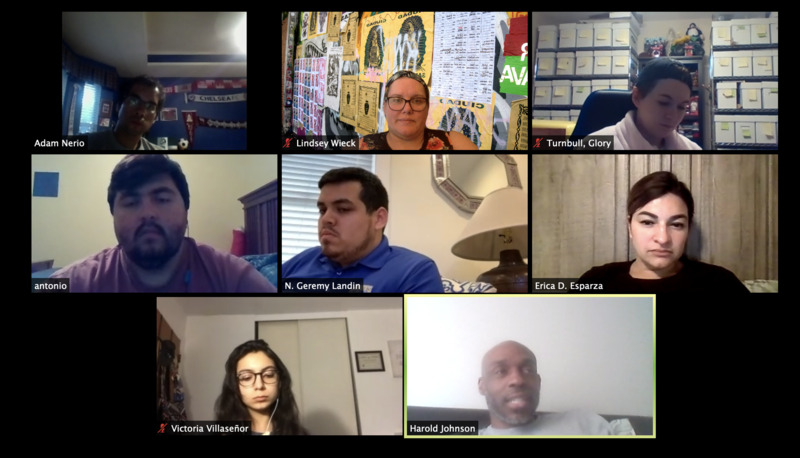
March 8 2020 - May 4, 2020
This entry is part one of two entries that capture the first six months of my graduate school experience. I’m a graduate student in the public history program at St. Mary’s University in San Antonio, Texas. I, like many students throughout all levels of education, felt a dramatic shift during or following spring break 2020. Most institutions, like mine, extended our spring break by a week to brace campus for transitioning fully online. At this time, I was enrolled in a course called “Conceptualizing your Capstone.” As the world began to catch on fire, I was just starting to piece together my final project which will enable me to graduate with my M.A. degree. Perfect timing.
These are images of what my first semester of graduate school kind of boiled down to: completing the initial, most crucial, stages of my capstone virtually and completing my fellowship with what I felt were limited resources. What is not pictured was my constant fear of the unknown.
Initial Anxieties
For my capstone project I’ll be looking at the development of ballet folklórico in San Antonio and its influence throughout the state of Texas. I was looking forward to digging in our university and local archives; Fiesta was around the corner and I would’ve used that as an opportunity to document the different folklórico groups set to perform; and most importantly I had planned on meeting with the community members I’m working with face-to-face. The last point there was particularly concerning for me. I’d have to reach out remotely to a community who seldom opens their vaults to outsiders. How was I going to establish credibility and convince these groups that they could trust me via an email or Facebook message? The whole concept of my capstone project also might’ve had to change. I was originally looking to create a narrative history of Ballet Folklórico in San Antonio by drawing on the experience of my community partners–they are the earliest 501(c)(3) groups established in the city.
In regard to my schoolwork, how was I going to produce legitimate work from the confines of my house? Was I even in the right place mentally and emotionally to perform at graduate level amidst social, political, and medical disarray that was being broadcasted? I was starting to get cabin fever; I could’ve ignored the commotion outside so I could focus, but that felt selfish. How could my mind be everywhere at once, yet my body needed to remain indoors? (These are actually a bunch of large questions I’ve had swirling in my head throughout the rest of March.)
In late March, one of my brothers who’s a Texas State Trooper was ordered to quarantine for two weeks after someone in his unit contracted the virus. Then in mid-April, my other brother came down with something that gave him body aches, chills, fever, and made him sleep all day. No respiratory issues, however, we had no idea what was going on. He got tested for COVID and his results took four days to come back. Both my brothers tested negative, but these two events made it seem like the virus was everywhere and inhibited my ability to think and produce sound work.
Adaptation
After a couple of dramatic weeks, I got to a point where I could realize the amount of privilege my family and I managed to hold on to regardless of the dystopian-like transitions we were going through as a society. My dad and brothers could still commute to work (that has never been compromised throughout the past nine months), and my mom and I have been able to work from home; neither of us experienced a cut to our pay nor hours; I could get back to a regular sleep schedule because I no longer had to commute from campus, which is on the other side of town, late at night; we have stable WiFi; we have insurance; we’ve been able to pay our bills on time.
In terms of academics, contrary to my initial anxieties, my experience in graduate school wasn’t really compromised. I had already established relationships with my peers and professors so Zoom classes and weekly meetings for my fellowship didn’t feel so awkward. Even if I didn’t have the first half of the semester to acquaint myself with my classmates, my generation is very much accustomed to digital communication. We literally grew up on it; we witnessed the evolution from wall phones to smart phones. Making digital connections isn’t a foreign concept to me. The pace of graduate school also didn’t change much. Yes, not having to commute to campus really alleviated a lot of my stress. However, the sense of urgency in graduate school did not fade one bit.
I also underestimated the digital literacy of older generations. Specifically of the ballet folklórico community throughout Texas. Through the power of Twitter, Facebook, JSTOR, online university archives, and Zoom, I was able to build upon my research for my capstone. The individuals and groups I reached out to for help were surprisingly eager and generous. Maybe we were all craving some new faces or voices to interact with, or maybe I underestimated the power of engagement. I was able to build upon my capstone, and was probably more productive with it given that I had to stay in one place and work. Optimism was in the air.
The first photo is a screenshot of our final presentations where we pitched our capstone idea to the St. Mary’s history department. We were originally set to present our capstone idea to the public history department (staff and students). Initially, I thought this experience would be compromised. I thought I’d miss out on forming connections with other professors in the program. However, there was a collective understanding these young academics (my peers and I) are in the midst of creating one of the most important pieces of our careers under unimaginable outside challenges. All hands were on deck in making sure we received the most help and access to whatever resources. It reinforced that I belonged to a community grounded in the belief that regardless of the circumstances, our duty is to assist each other in our pursuit to public history. I hope other graduate students across the city, state, country, and world experienced this same empathy.
-
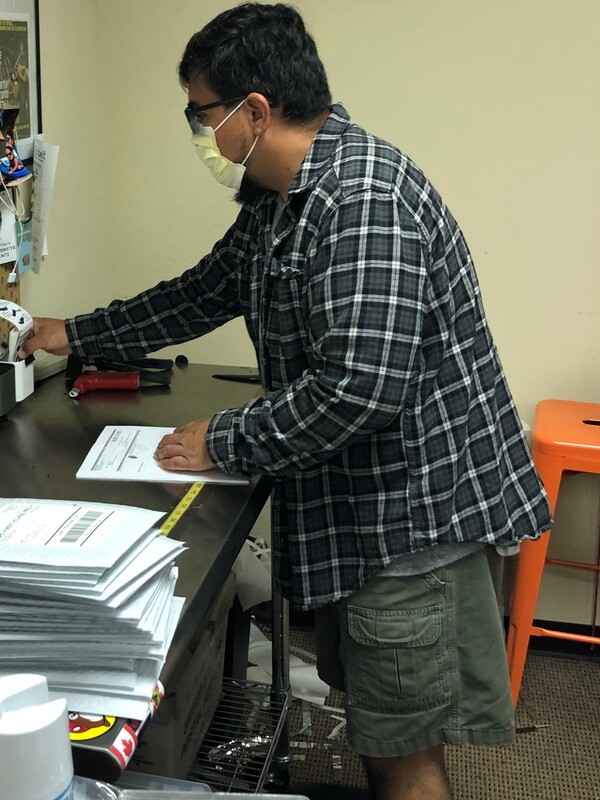
2020-05-15
The photos show my friend Jacob who tried out a variety of masks to suit his personality. He is very crafty and likes to customize everything he possibly can. Unsatisfied with the poor quality of disposable masks, he made a very unattractive mask out of an old t-shirt. Although he liked the way the mask hugged his ear, the thickness of the fabric made it difficult for him to breathe. Jacob eventually sewed his own mask much to his wife’s chagrin. He was pleased that it provided enough coverage over 60% of his face, and that he figured out a way to make the straps adjustable.
-
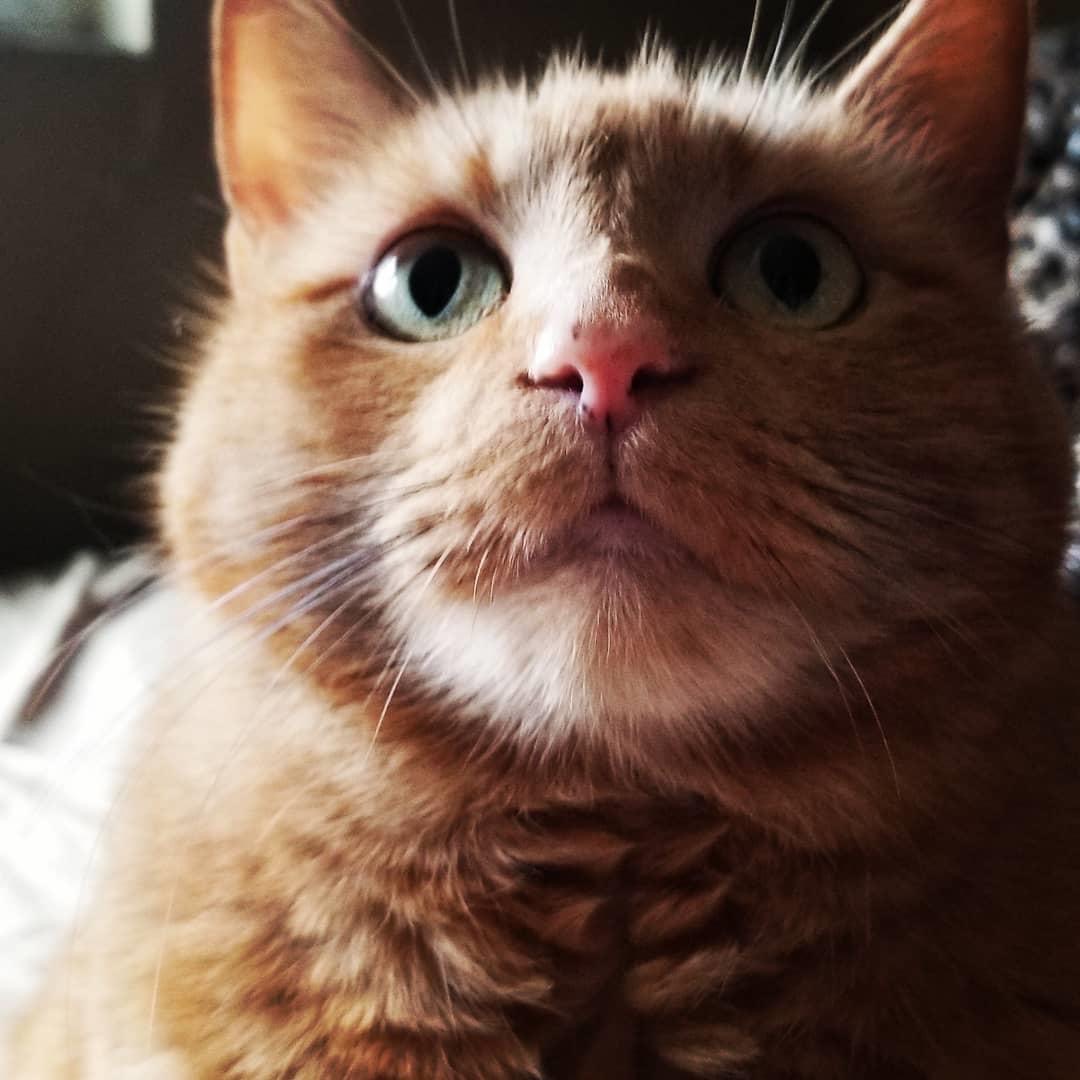
2020-08-11
The pandemic disrupted the frequent trips I take to visit my friend Chrissie in California. We planned on celebrating her birthday together in person, but since we both lived in hot spots we decided it was best to postpone our festivities. I used some of the money I would have spent on traveling to buy her some very personalized gifts. When she received her presents I asked her to meet me on the Houseparty app so that I could see her reactions. They were priceless. I commissioned an artist friend to draw her beloved cat Dulce which I then printed on a poster. To add a Texas touch, I also got her a James Avery charm bracelet with an inside joke engraved on it. Even though I would have much rather hung out with Chrissie in person, this celebration was still special. Being away from made me think about how much I love and appreciate her. Quarantine allowed me the time to reflect on what makes her unique and what gifts would put a smile on her face.
-
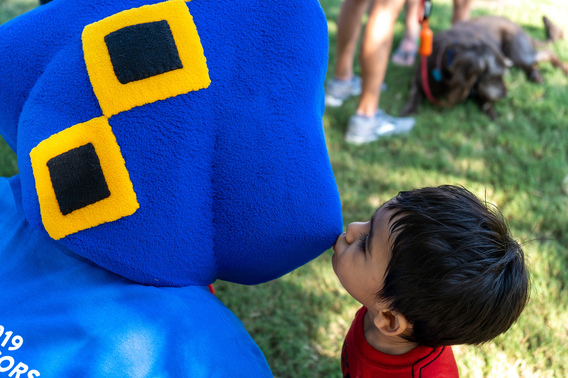
2020-09-12
This email shows even through the pandemic of COVID-19 St. Mary's is going to continue to try to keep annual events running. Virtually accommodating participants from every city, state and country to participate. Personally I think this event will allow the St. Mary’s community to show their pride, even through COVID-19 the Rattler nation is still staying connected. In addition, it allows our members to do some normal activities that we did before the pandemic. We are all quarantined and allowing us to walk/run/hike from your home is a great idea.
As a member of the St. Mary's Community I received the email.
-
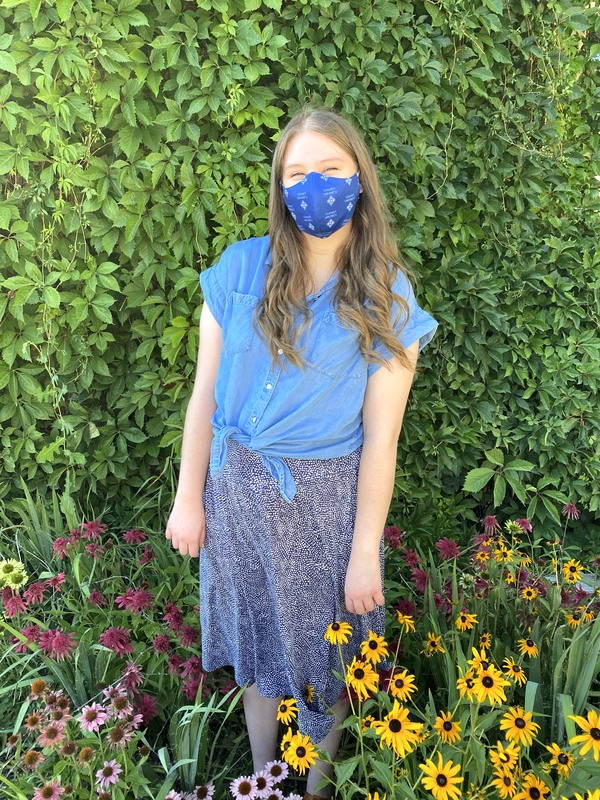
2020-09-03
I was really excited for my first semester at St. Mary’s as a graduate student. After several months of social-distancing and canceling plans due to the pandemic, I was ready to be busy again. I felt like I had a really long, boring summer. St. Mary’s sent me this mask and my friend took grad school pictures for me. It was a really nice gesture from the university since I am learning remotely in Utah. To some degree, I’ve felt a little disconnected from everyone else in San Antonio. But also, all the other students in my program are also learning remotely too. So, it kinda feels like we’re in the same boat together.
-
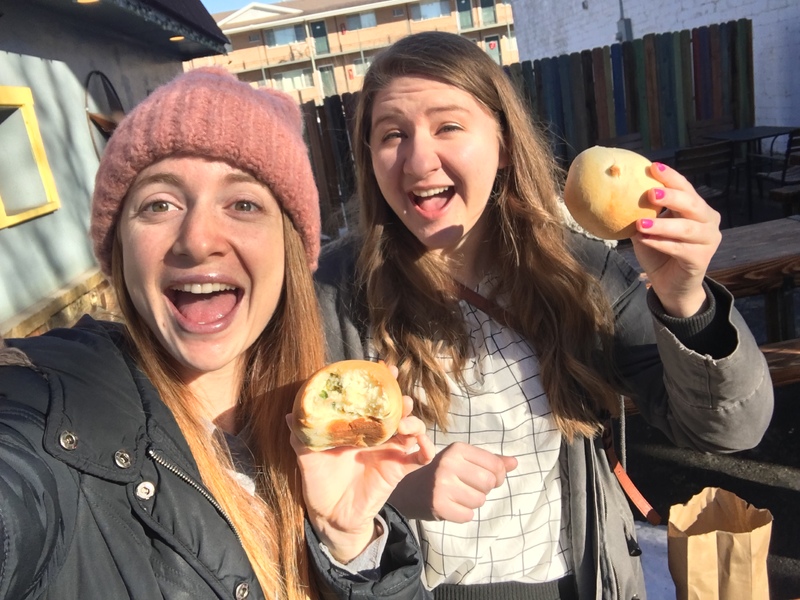
2020-09-02
COVID-19 has affected several of my relationships and how I have stayed in contact with friends. I wanted to talk about how COVID-19 has changed my interactions with one of my friends, Angie. I have known Angie for several years but we became really close friends when we attended the same church congregation in Provo, Utah from 2015-2016. When I graduated from school in Spring 2018, I moved away from Provo for an internship and I haven’t lived in Provo since. Angie also graduated around the same time and she continued to work in the same area.
Normally, Angie and I will visit one another every other month and get lunch or I would spend the weekend with her at her apartment. The last time I was with Angie before COVID-19 lockdown began was in February. I was staying with her for a weekend in Provo, Utah for a wedding. On February 7, we got Korean BBQ bowls and went to an art museum. The next morning we woke up early and got kolaches. And I was thinking we’d get together soon in another month or so.
For Angie’s birthday that same month, I sent her a sun hat because we made plans with our other two friends to go to Myrtle Beach, South Carolina in June. But with the news of the onset of COVID-19 a few weeks later, we ended up canceling those plans.
After a FaceTime call in April, we both figured out that we needed ways to stay connected while social-distancing safely. However, we didn’t have any new things to report because we were social-distancing. So we started our audiobook club to give ourselves something to chat about. So far we have listened and discussed The Only Plane in the Sky: An Oral History of 9/11, I Am Malala: The Story of the Girl Who Stood Up for Education and Was Shot by the Taliban, and White Fragility: Why It’s So Hard for White People to Talk About Racism. We are currently listening to Born a Crime: Stories From a South African Childhood. Neither of us remembered who suggested our book club, but I’m glad we have stayed connected through it. Both Angie and I have enjoyed each of these books. They have made us much more knowledgeable about the world around us and I like discussing them with Angie. My favorite book we read together was White Fragility. We read it in response to the death of George Floyd and Breonna Taylor. As white women, we realized we needed to better educate ourselves. We had a tough conversation, but I’m glad I had it with Angie who is incredibly compassionate and thoughtful.
Besides our book club, we have had video chats with some other friends and we’ve texted one another. I finally saw Angie in person while she was passing through where I lived. We cautiously sat outside 6 feet apart and ate popsicles on my grass lawn. And I met her boyfriend for the first time!
The pandemic has changed how I connect with my friends. I rely much more on technology and scheduled calls. I have learned to cut myself and others some slack for this situation because there is so much more social friction than before. Weirdly enough,in some ways it has helped with my social anxiety because I don’t feel FOMO (a.k.a. The “fear of missing out”). We’re all in the same crappy boat. The pandemic has also helped me think about why certain people are my friends. Now it’s less about proximity or someone’s availability but more so about someone’s loyalty, kind heart, or strong values.
-
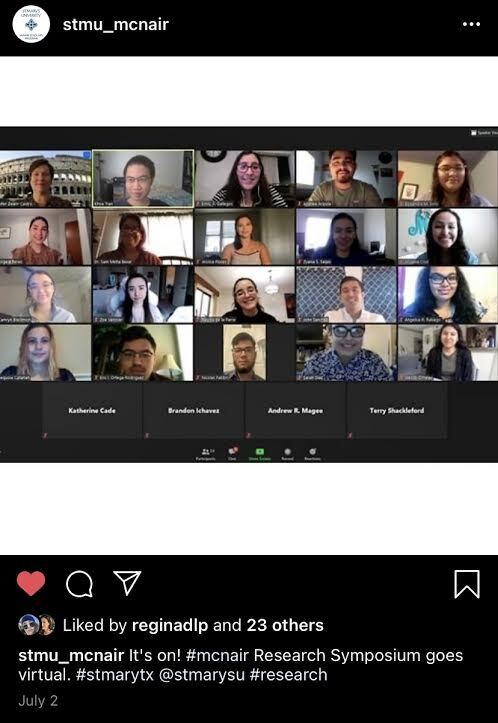
2020-07-02
The post is a screenshot from the annual McNair Scholars Program Research Symposium from the summer. The screenshot captures students and faculty from the program before they began their presentations over zoom. The McNair Scholars program prepares underrepresented students for graduate school. Students have a faculty mentor who advises them on a research project during the summer, where they write a paper, prepare for graduate school applications, and then later present the research at the annual research symposium. Usually, the program takes place on the St. Mary’s University campus, and students are provided campus resources such as housing and meal plans. They can meet with faculty and peers in person. Due to COVID-19, the program had to be completely virtual; every program meeting utilized zoom. The McNair Scholars summer research program is one example of college activities that had to adapt to the changing world with COVID-19. Although students were still able to meet virtually and present research, there were limitations to not being on campus, such as what research you could conduct and the resources and accessibility of having workspaces on campuses as many students were working at home. The picture also represents the new normal of large gatherings, especially for academic spaces. All of our classes resemble this image now.
-
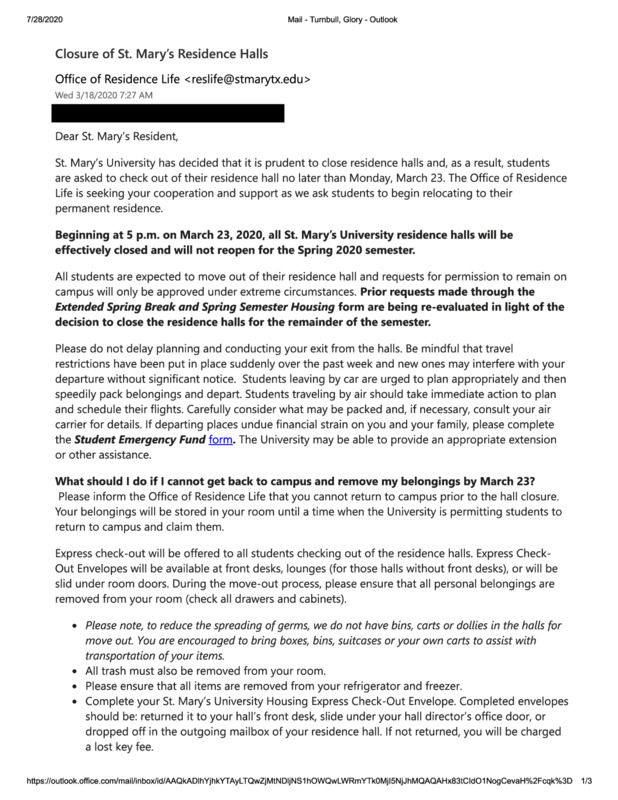
2020-03-09
COVID-19 caused St. Mary's University to shut down rapidly on campus after spring break. Most students didn't return after spring break, and had to make later plans to return to get their personal items (including clothes, textbooks, and other items that they may have urgently needed). Some students, who didn't have a place to return to, worked with St. Mary's residence life to make arrangements to remain in the dorms. Students who stayed faced a unique set of challenges and uncertainty with what lay ahead. Combined degree student (undergraduate and graduate) Glory Turnbull, a resident in on campus housing, reflects in this oral history on what these rapid closures of campus meant to them.
-
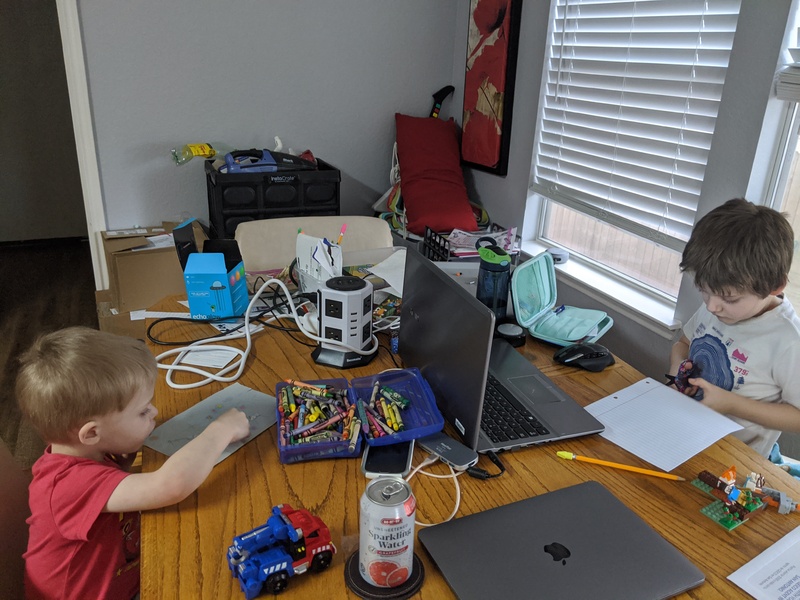
2020-09-23
I have been working from home and caring for both of my kids with my spouse since March. It is challenging and chaotic, but also it brings a lot of joys in watching kids develop. Teaching at the university level has also brought its challenges and joys, but I hope that by making my own struggles visible, it makes me more relatable to students.
 2020-08-29
2020-08-29 02/01/2020
02/01/2020 06/01/2020
06/01/2020 10/01/2020
10/01/2020 2020-04-01
2020-04-01 2020-03-11
2020-03-11 2020-04-29
2020-04-29 2020-05-09
2020-05-09 May 5, 2020 - August 31, 2020
May 5, 2020 - August 31, 2020 March 8 2020 - May 4, 2020
March 8 2020 - May 4, 2020 2020-05-15
2020-05-15 2020-08-11
2020-08-11 2020-09-12
2020-09-12 2020-09-03
2020-09-03 2020-09-02
2020-09-02 2020-07-02
2020-07-02 2020-03-09
2020-03-09 2020-09-23
2020-09-23